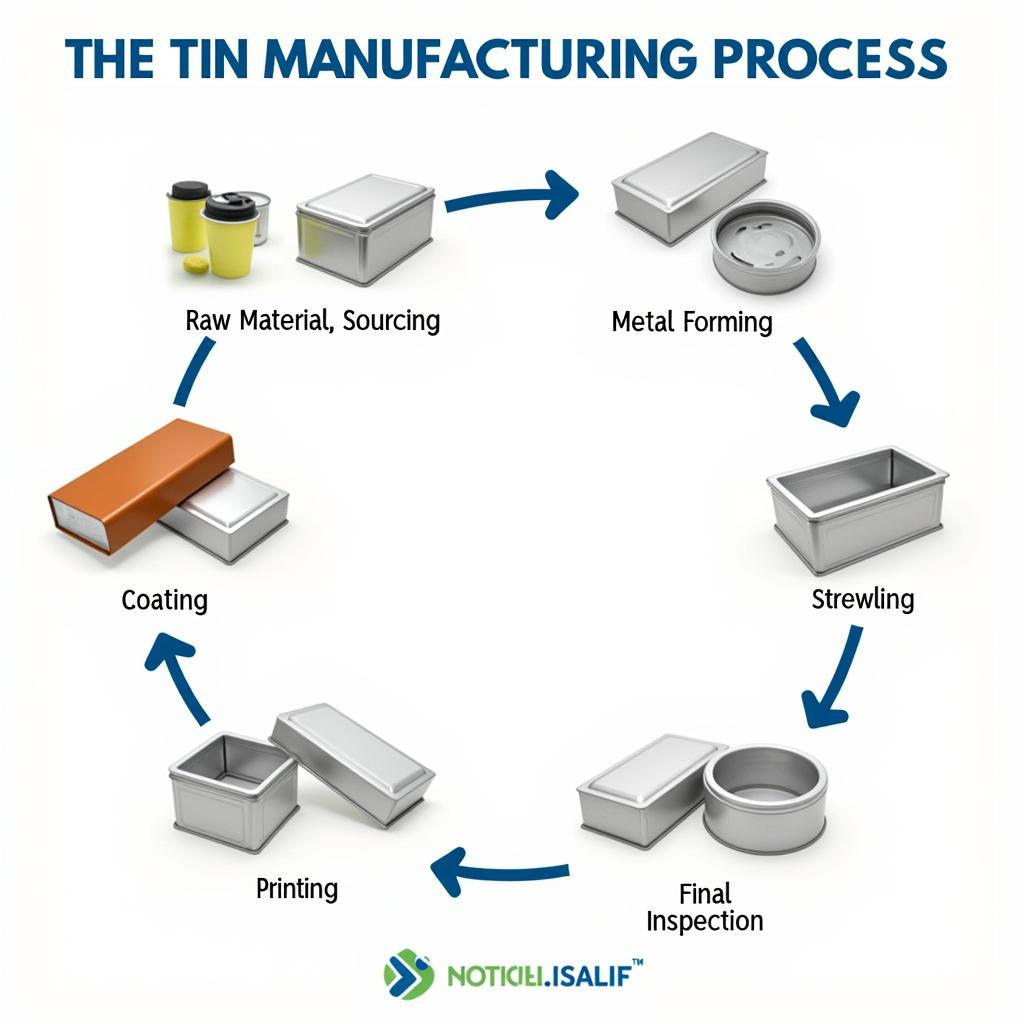The “Tin Manufacturing Process” might sound simple at first glance, but behind this seemingly straightforward phrase lies a fascinating world of industrial innovation and intricate procedures. From the moment raw materials enter the factory gates to the final product ready for consumer shelves, the tin manufacturing process involves a carefully orchestrated series of steps, each playing a crucial role in ensuring the quality, safety, and durability of the final product.
 Metal Can Manufacturing Process
Metal Can Manufacturing Process
Unraveling the Tin Manufacturing Process: A Step-by-Step Breakdown
While the specifics might vary depending on the type of tin and its intended use, the general tin manufacturing process follows a well-defined path:
1. Material Sourcing and Preparation: Laying the Foundation
The journey begins with sourcing the primary raw material: tinplate. This thin sheet of steel, coated with a protective layer of tin, forms the building block of the entire process.
“Sourcing high-quality tinplate is non-negotiable,” shares Nguyen Van Minh, a seasoned engineer at a leading tin can manufacturing facility in Vietnam. “The properties of the tinplate, including its thickness, temper, and coating quality, directly impact the final product’s strength, corrosion resistance, and suitability for different applications.”
2. Shaping the Future: The Art of Metal Forming
Once the tinplate arrives at the factory, it undergoes a series of transformations, starting with cutting and stamping. Precisely engineered dies shape the flat tinplate into the familiar cylindrical bodies and circular lids that characterize most tin cans.
This stage demands meticulous attention to detail and dimensional accuracy. Any deviation from the set parameters can compromise the can’s integrity and its ability to withstand internal pressure during processing and storage.
3. A Protective Embrace: The Importance of Coating
To further enhance the can’s resistance to corrosion and interaction with the contents, an additional internal coating is applied. This layer, often made from epoxy or other food-grade polymers, acts as a barrier, preserving the quality and flavor of the packaged goods.
4. Making a Mark: The Art of Printing and Labeling
The seemingly simple act of printing on a tin can involves a sophisticated process designed to withstand the rigors of handling, transportation, and storage. High-speed printing machines employ various techniques, including offset lithography and flexography, to transfer vibrant colors and intricate designs onto the curved surface of the cans.
5. The Final Touch: Inspection and Quality Control
Before being deemed ready for the market, each tin can undergoes rigorous quality checks at multiple stages of the manufacturing process. These inspections, often aided by automated vision systems and other advanced technologies, ensure that only cans meeting the highest standards of dimensional accuracy, coating integrity, and visual appeal reach the final packaging stage.
The Importance of Understanding the Tin Manufacturing Process
A deep understanding of the tin manufacturing process is crucial not just for manufacturers but also for businesses that rely on tin cans for packaging their products. This knowledge empowers informed decision-making regarding:
- Material selection: Choosing the right type of tinplate and coating based on the specific product and its storage requirements.
- Packaging design: Optimizing can design and dimensions to balance functionality, aesthetics, and cost-effectiveness.
- Quality control: Implementing robust quality control measures throughout the supply chain to ensure product safety and consumer satisfaction.
 Tin Can Quality Inspection
Tin Can Quality Inspection
Conclusion: A Testament to Precision and Innovation
The tin manufacturing process, often overlooked in our daily lives, stands as a testament to human ingenuity and industrial precision. From humble beginnings as a simple sheet of metal, the tin can evolves through a series of intricate steps, each contributing to its final form: a reliable, durable, and sustainable packaging solution that safeguards the quality of countless products we rely on every day.
Understanding this process empowers businesses and consumers alike to appreciate the complexity behind seemingly simple objects and make informed choices that prioritize quality, safety, and sustainability.